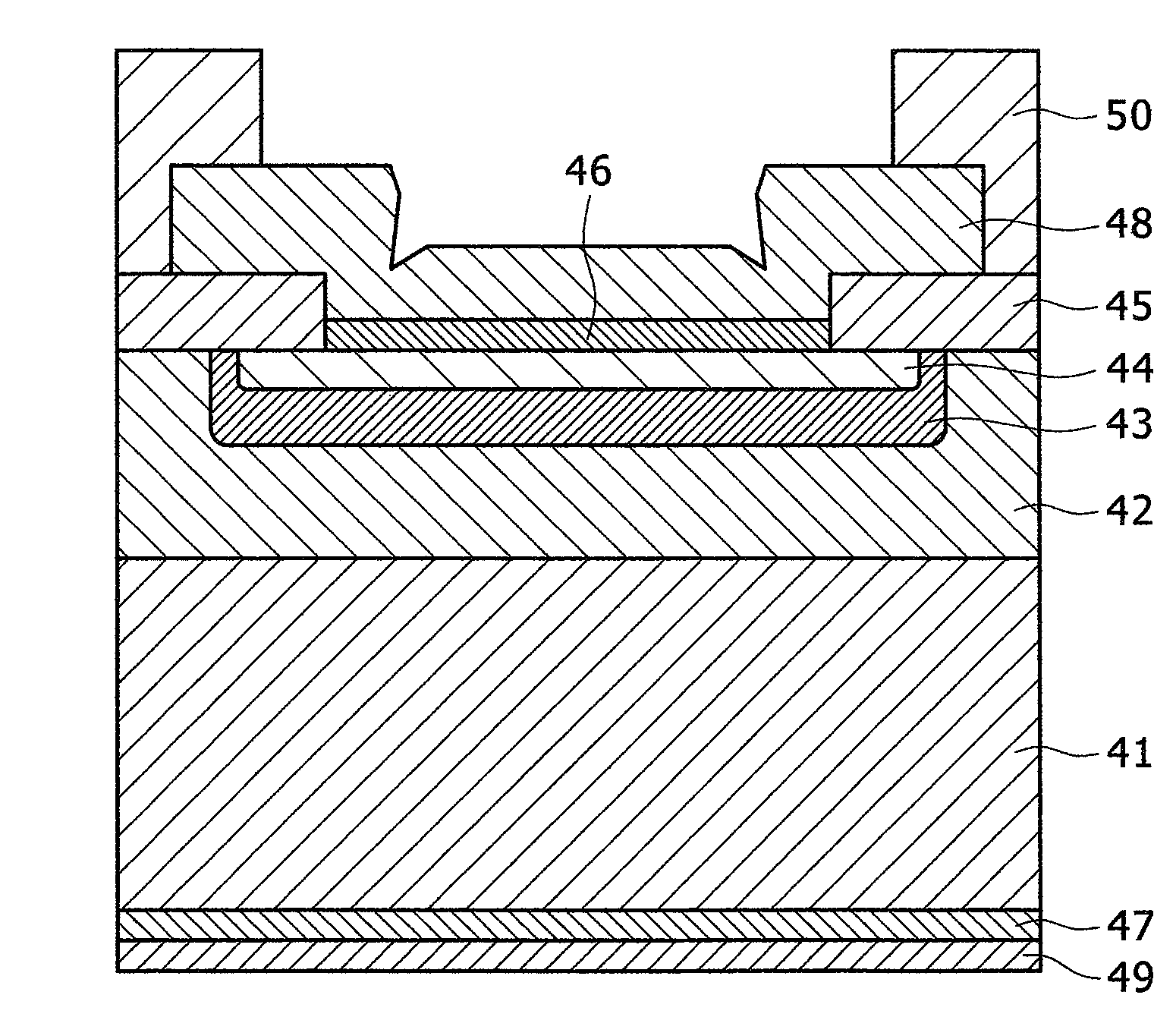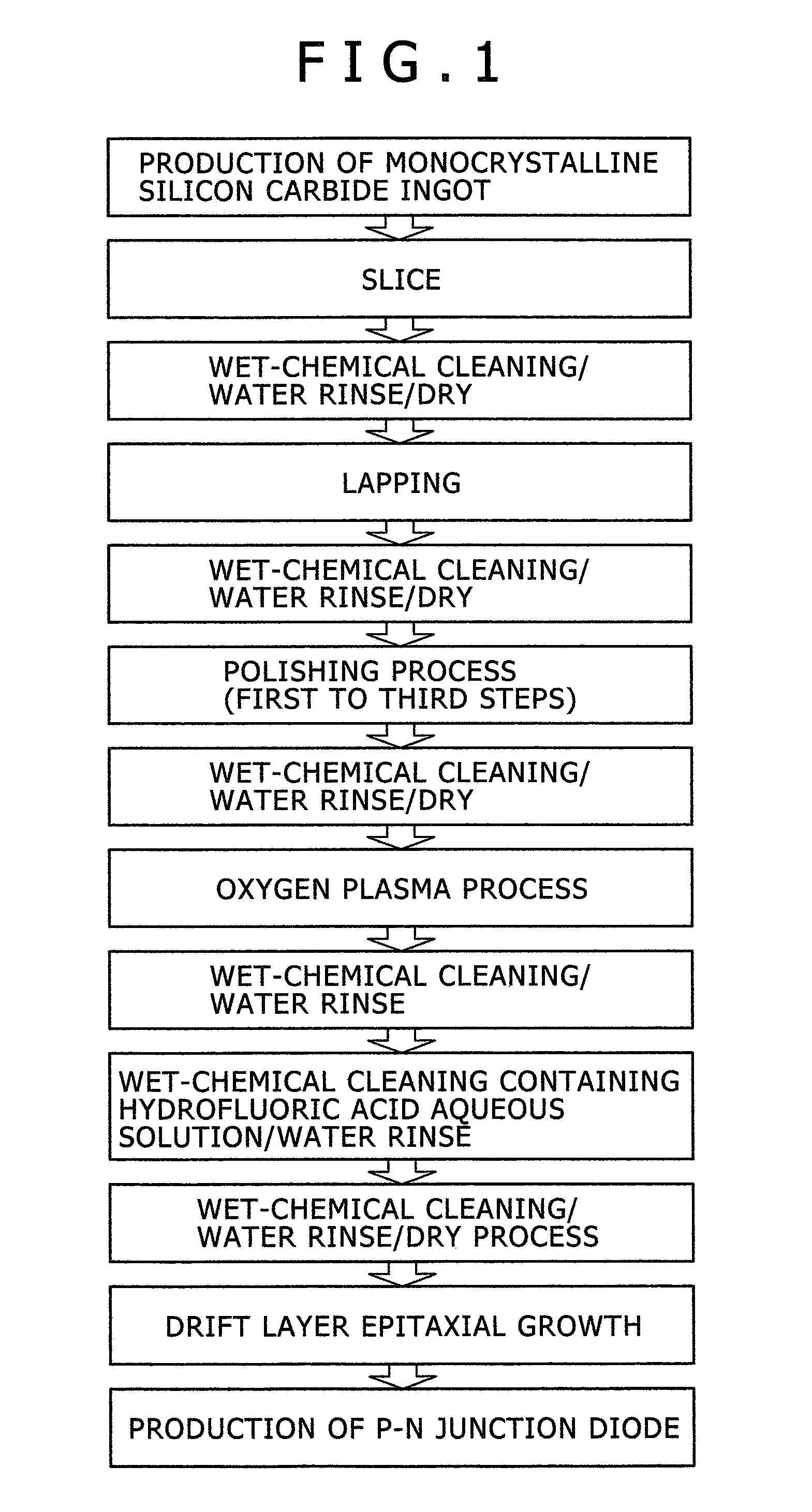Manufacturing method of semiconductor device
a manufacturing method and technology of semiconductor devices, applied in the direction of semiconductor devices, electrical equipment, basic electric elements, etc., can solve the problems of inadequate silicon use, insufficient effects, and hardly formation of film primarily including silicon dioxid
- Summary
- Abstract
- Description
- Claims
- Application Information
AI Technical Summary
Benefits of technology
Problems solved by technology
Method used
Image
Examples
first embodiment
[0071]A first embodiment will be described using FIGS. 1 to 6. The first embodiment is an embodiment applied to manufacturing of a p-n junction diode. In FIG. 1, a process flow of a manufacturing method of a p-n junction diode according to the present invention is shown. In the first place, an ingot made of monocrystalline silicon carbide (4H—SiC) was produced in order to manufacture the monocrystalline silicon carbide substrate. In the manufacturing of the ingot, there was used a sublimation method that is currently the most common method. However, another monocrystalline silicon carbide growth technique such as a dissolution method may be used. As monocrystalline, monocrystalline silicon carbide having other crystal forms such as 2H—SiC, 6H—SiC, and 3C—SiC can be used, in addition to 4H—SiC. 3×1018 cm−3 of nitrogen was contained in monocrystalline silicon carbide of the ingot, and the ingot was of a high-concentration n-type. Next, the produced ingot was sliced to obtain monocryst...
second embodiment
[0088]A second embodiment will be described using FIGS. 6 to 10. The second embodiment is an embodiment applied to manufacturing of a p-n junction diode. A 4H—SiC, 4° off monocrystalline silicon carbide substrate used in the second embodiment was purchased from a manufacturer of a substrate with designated specification. The front surface of the crystal substrate is a silicon plane ((0001) plane), and the back surface thereof is a carbon plane ((000-1) plane). The front surface has a (0001) plane with 4° off-angle inclined toward [11-20]. The epitaxial growth of the drift layer on the substrate was also carried out by the manufacturer of a substrate. After inspection of the delivered substrate, it was found that the diameter was 76.2 mm at the most, and primary and secondary orientation flats were formed. The thickness thereof was 350 μm.
[0089]The concentration of nitrogen of the epitaxial layer was 2×1016 cm−3 and the thickness thereof was 8 μm, which were as designated specificati...
third embodiment
[0097]A third embodiment will be described using FIGS. 11A to 11G. The third embodiment is an embodiment in which the present invention was applied to manufacturing of a JBS diode formed by combining a Schottky barrier and a p-n junction. FIGS. 11A to 11C are cross sectional views each showing a manufacturing process of the JBS diode of the third embodiment. A termination area for relaxing the electric field was formed around the JBS diode, but the illustration thereof was omitted in FIGS. 11A to 11F. As shown in FIG. 11C, the JBS diode of the third embodiment includes an n-type drift layer 112 containing nitrogen which is provided on a front surface of a monocrystalline silicon carbide substrate 111 and has a thickness of about 20 μm, a p-type doped layer 113 containing Al which is provided on a part of a surface of the drift layer 112 and has a thickness of 1 μm, and a high-concentration p-type layer 114 containing Al which is provided on the upper side of the p-type doped layer 1...
PUM
| Property | Measurement | Unit |
|---|---|---|
| thickness | aaaaa | aaaaa |
| off-angle | aaaaa | aaaaa |
| off-angle | aaaaa | aaaaa |
Abstract
Description
Claims
Application Information
 Login to View More
Login to View More - R&D
- Intellectual Property
- Life Sciences
- Materials
- Tech Scout
- Unparalleled Data Quality
- Higher Quality Content
- 60% Fewer Hallucinations
Browse by: Latest US Patents, China's latest patents, Technical Efficacy Thesaurus, Application Domain, Technology Topic, Popular Technical Reports.
© 2025 PatSnap. All rights reserved.Legal|Privacy policy|Modern Slavery Act Transparency Statement|Sitemap|About US| Contact US: help@patsnap.com



